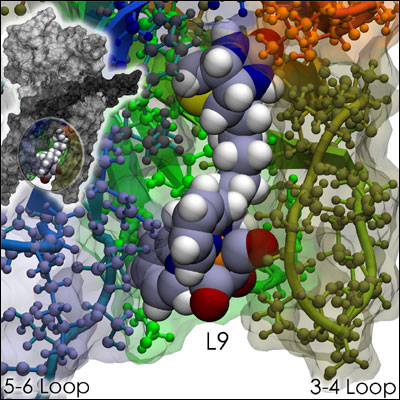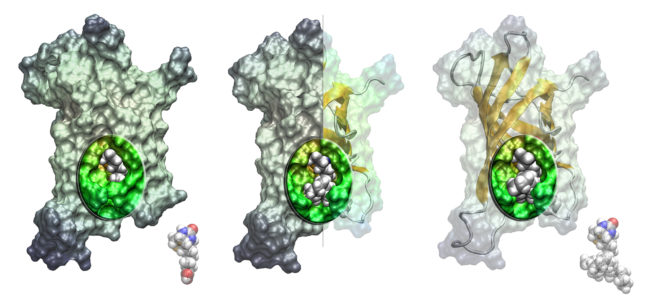In press, available from the journal Bioconjugate Chemistry. The modeling study for the avidin–biotin structure and the biotin derivatives were completed with the molecular dynamics program NAMD on a Dual G4/450 loaned to me from Apple for development work, for which I am grateful (I've performed molecular dynamics simulations with the Walrus). I did manage to smoke the motherboard during this experience, for which I apologize. Given the state of the machine after the autopsy, I'm hoping no one (especially Eric Zelman!) asks for it back, even when I'm 64.
I made mention of the reasons for some of this work in an interview I did for nanotech.biz, completely unrelate to the other content, in case anyone wants some background.

Shelly James, Kevin P. Maresca, Damian G. Allis, John F. Valliant, William Eckelman, John W. Babich, and Jon Zubieta
Abstract: Biotin and avidin form one of the most stable complexes known (KD = 10-15M-1) making this pairing attractive for a variety of biomedical applications including targeted radiotherapy. In this application one of the pair is attached to a targeting molecule while the other is subsequently used to deliver a radionuclide for imaging and/or therapeutic applications. Recently we reported a new single amino acid chelate (SAAC) capable of forming robust complexes with Tc(CO)3 or Re(CO)3 cores. We describe here the application of SAAC analogs for the development of a series of novel radiolabeled biotin derivatives capable of forming robust complexes with both Tc and Re. Compounds were prepared through varying modification of the free carboxylic acid group of biotin. Each 99mTc complex of SAAC-biotin was studied for their ability to bind avidin, susceptibility to biotinidase and specificity for avidin in an in vivo avidin-containing tumor model. The radiochemical stability of the 99mTc(CO)3 complexes was also investigated by challenging each 99mTc-complex with large molar excesses of cysteine and histidine at elevated temperature. All compounds were radiochemically stable for greater than 24 hours at elevated temperature in the presence of histidine and cysteine. Both [99mTc(CO)3(L6)]+1 [TcL6; L6 = biotinyl- amido- propyl- N,N- (dipicolyl)- amine] and [99mTc(CO)3(L12a)]+1 (TcL12; L12 = N,N-(dipicolyl)- biotin- amido- Boc- lysine; TcL12a; L12a = N,N- (dipicolyl)- biotin- amide- lysine) readily bound to avidin whereas [99mTc(CO)3(L9)]+1 [TcL9; L9 = N,N- (dipicolyl)- biotin- amine] demonstrated minimal specific binding. TcL6 and TcL9 were resistant to biotinidase cleavage while TcL12a, which contains a lysine linkage, was rapidly cleaved. The highest uptake in an in vivo avidin tumor model was exhibited by TcL6, followed by TcL9 and TcL12a, respectively. This is likely the result of both intact binding to avidin and resistance to circulating biotinidase. Ligand L6 is the first SAAC analogue of biotin to demonstrate potential as a radiolabeled targeting vector of biotin capable of forming robust radiochemical complexes with both 99mTc and rhenium radionuclides.Computational simulations were performed to assess biotin-derivative accommodation within the binding site of the avidin. These calculations demonstrate that deformation of the surface domain of the binding pocket can occur to accommodate the transition metal-biotin derivatives with negligible changes to the inner-β-barrel, the region most responsible for binding and retaining biotin and its derivatives.
P.S. This publication is also of some use for explaining the series of images on the current departmental brochure for the Syracuse U. Chemistry Department. Steric interactions affect the local geometries of protein binding pockets. And a good thing, too.

Click on the image for a larger version.
www.apple.com
www.applecorps.com
chemistry.syr.edu/faculty/zubieta.html
www.molecularinsight.com
www.chemistry.mcmaster.ca/people/faculty/valliant/index.html
pubs.acs.org/journals/bcches/index.html
www.ks.uiuc.edu/Research/namd/